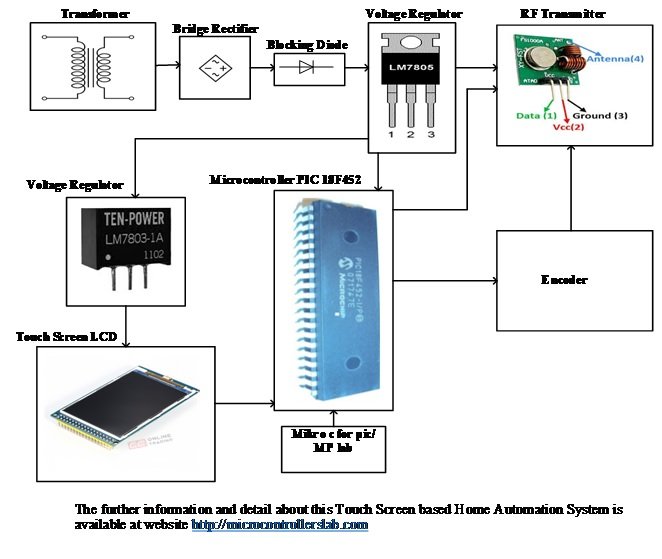Touch screen based home automation system is a system that controls the home appliances automatically such as fans, fridge, lights and all type of other appliances which are mostly used in homes. With the passage of time, the world is becoming advance more and more as well as our daily used items are also becoming smart and smart. Similarly, home appliances are also becoming smart and smart therefor it is so much necessary that their control should be also smart means their control should be automatically. Currently, in our homes we have been using wall switches for controlling the home appliances which are installed at different walls of our homes. Sometimes, it is very difficult for the user to operate these switches specially for the elder and physical handicapped user.
So many systems are available in market which have been using for controlling the home appliances automatically, but they are not so much efficient and reliable as well as their cost is also so much high. Beside this these systems are also do not have touch screen facility for controlling the home appliances. On concentrating the above issues here, we have designed a device that is called a touch screen based home automation system. This system has designed with the help of touch screen LCD, ac transformer, bridge rectifier, voltage regulator, RF transmitter, encoder and microcontroller 18F452 belongs to pic family. This system is more efficient, more reliable and less costly as compared to other systems. The block diagram of this touch screen based home automation system with all their essential components is shown in figure 1.
Block Diagram of Touch Screen Based Home Automation System
Here is the block diagram of touch screen based home automation system with all their essential components,
Figure 1Block Diagram of Touch Screen Based Home Automation System
Working of Touch Screen Based Home Automation System
This touch screen based home automation system turned no or off the home appliances automatically when is directly connected with 220V ac supply. When is connected with 220V ac supply then single-phase ac transformer steps down 220V ac into 6 or 9V ac. Because this touch screen based home automation system mostly consists of electronics components therefore these ac voltages are converted into dc with the help of bridge rectifier. Then these dc voltages are regulated into 5V dc with the help of voltage regulator. LM 8705 voltage regulator have been used here. Microcontroller and RF transmitter are operated at 5V dc therefore these are powered up with this voltage regulator. Similarly, the touch screen LCD panel operated at 3V dc therefore it is powered up with separate 3V voltage regulator and here LM 7803 voltage regulator have been used for this purpose.
Microcontroller is basically the main intelligent controller of this touch screen based home automation system. It is programmed in c language with the help of mikro/c software and is interfaced with RF transmitter, encoder and touch screen LCD. This whole system consists of two circuits one is RF transmitter circuit which consists microcontroller with touch screen LCD panel and second one is RF receiver circuit which consist of microcontroller and RF receiver as well as with output load. For demonstration purposes we can connect different loads at output side of RF receiver circuit. These both RF transmitter and RF receiver circuits work on the base of radio frequency waves. When we shell press switch 1 from touch screen LCD panel then microcontroller will receive this signal and will give the signal high to RF transmitter. Because RF transmitter is coupled with RF receiver through radio frequency waves therefor RF receiver will receive this signal and then this will switch on the load 1. Similarly, we can easily switch on or off all the loads.
Applications and Advantages Touch Screen Based Home Automation System
- This touch screen based home automation system could be installed in domestic and industrial building for controlling their loads automatically.
- This system could be installed in that remote areas where conventional switches are permitted to use such as highly inflammable areas.
- This system is less costly, more efficient and more reliable as compared to other home automation systems.
can i have the full project report